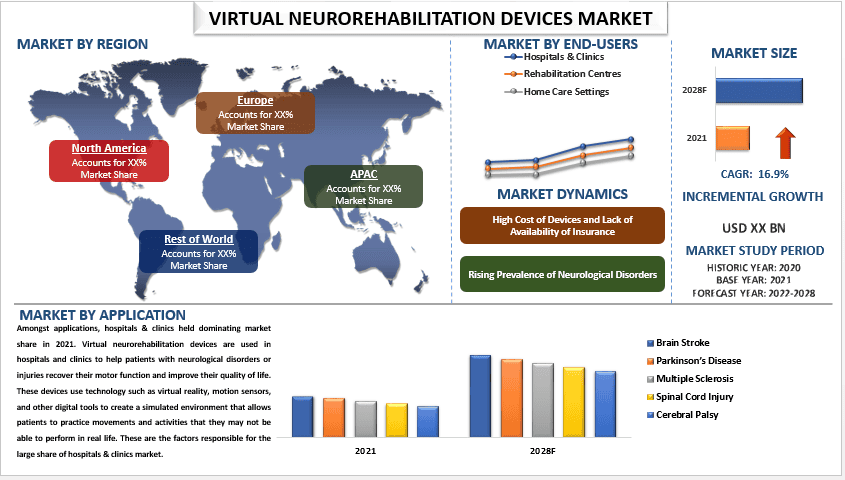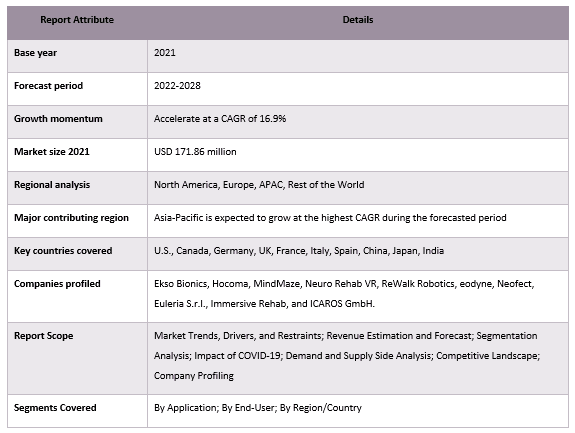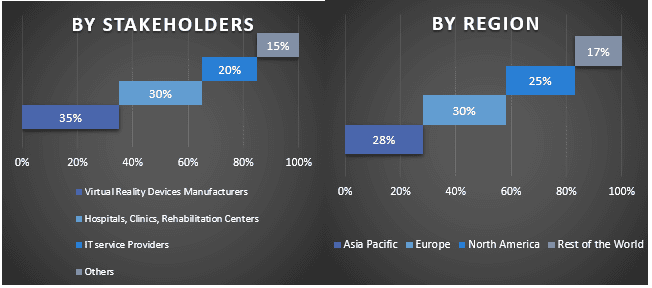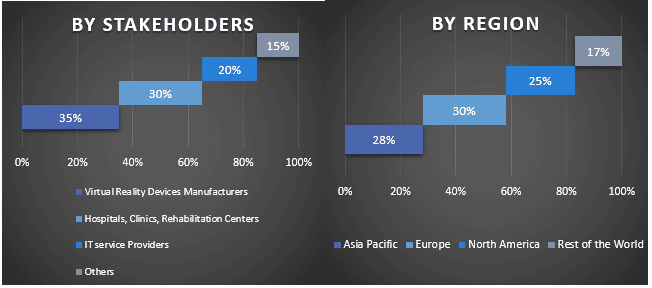Emphasis on Application (Brain Stroke, Parkinson’s Disease, Multiple Sclerosis, Spinal Cord Injury, and Cerebral Palsy); and End-Users (Hospitals & Clinics, Rehabilitation Centers, and Home Care Settings); and Region/Country

The Virtual Neurorehabilitation Devices market is expected to grow at a strong CAGR of 16.9% during the forecast period. Virtual neurorehabilitation devices are technological solutions that use virtual reality and other interactive technologies to aid in the rehabilitation of individuals with neurological impairments. These devices offer a non-invasive and engaging way to improve motor function, cognitive abilities, and other neurological functions, making them a popular alternative to traditional rehabilitation methods. Virtual reality (VR) neurorehabilitation devices have become increasingly popular in the globally over the past few years as virtual reality neurorehabilitation devices offer an innovative approach to therapy that can help patients recover faster and more effectively. This is mainly due to the presence of key market players, along with the frequent product launches in the country. For instance, in October 2020, Neuro Rehab VR announced the release of its XR Therapy System, a clinically validated and FDA-registered virtual reality (VR) therapy system for neurological rehabilitation and physical therapy treatment and assessment in clinical environments. Additionally, the emerging economies are increasing healthcare IT budget and a high awareness about the availability of advanced rehabilitation techniques also attributes to the market growth.
Some of the major players operating in the market include Ekso Bionics, Hocoma, MindMaze, Neuro Rehab VR, ReWalk Robotics, eodyne, Neofect, Euleria S.r.l., Immersive Rehab, and ICAROS GmbH Several M&As along with partnerships have been undertaken by these players to facilitate customers with hi-tech and innovative products/technologies.
Insights Presented in the Report
“Amongst application, the cerebral palsy segment witnessing the fastest growth in the market in 2021”
Based on application, the market is categorized into brain stroke, Parkinson’s disease, multiple sclerosis, spinal cord injury, and cerebral palsy. Amongst these, the cerebral palsy segment witnessing the fastest growth in the market in 2021. Cerebral palsy (CP) is a group of disorders that affect movement, posture, and muscle tone. CP is caused by damage to the developing brain, which can occur before, during, or shortly after birth. Virtual neurorehabilitation devices are a type of technology that can be used to provide therapy to individuals with CP remotely. The virtual neurorehabilitation devices market growing due to the rising cases of cerebral palsy and the growing demand of advance technology for virtual neurorehabilitation. For instance, according to the World Health Organization (WHO), cerebral palsy (CP) is the most common childhood disability, affecting approximately 17 million people globally. Here are some additional statistics on CP globally.
“Amongst end-users, the hospitals & clinics held dominating market share in 2021”
Based on the end-users, the market is categorized into hospitals & clinics, rehabilitation centers, and home care settings. Among these, hospitals & clinics held dominating market share in 2021. Virtual neurorehabilitation devices are used in hospitals and clinics to help patients with neurological disorders or injuries recover their motor function and improve their quality of life. These devices use technology such as virtual reality, motion sensors, and other digital tools to create a simulated environment that allows patients to practice movements and activities that they may not be able to perform in real life. These are the factors responsible for the market the large share of hospitals & clinics.
“Asia-Pacific is expected to grow with the highest CAGR during the forecast period”
The Asia-Pacific is the most favorable region for the growth of the virtual neurorehabilitation market. This is mainly due to the presence of emerging economies in the region such as China and India. The technological advancements, along with the rising healthcare expenditure in the region attributes to the fast growth of the market. Furthermore, governments of various nations are taking initiatives to support the development of the virtual neurorehabilitation devices market in the region.
Virtual Neurorehabilitation Devices Market Report Coverage

Reasons to buy this report:
Customization Options:
The global virtual neurorehabilitation devices market can further be customized as per the requirement or any other market segment. Besides this, UMI understands that you may have your own business needs, hence feel free to connect with us to get a report that completely suits your requirements.
1. Market Introduction
2. Research Methodology Or Assumption
3. Market Synopsis
4. Executive Summary
5. Impact Of Covid-19 On The Virtual Neurorehabilitation Devices Market
6. Virtual Neurorehabilitation Devices Market Revenue (usd Bn), 2020-2028f
7. Market Insights By Application
8. Market Insights By End User
9. Market Insights By Region
10. Virtual Neurorehabilitation Devices Market Dynamics
11. Virtual Neurorehabilitation Devices Market Opportunities
12. Virtual Neurorehabilitation Devices Market Trends
13. Demand And Supply-side Analysis
14. Value Chain Analysis
15. Competitive Scenario
16. Company Profiled
17. Disclaimer
Research Methodology for the Virtual Neurorehabilitation Devices Market Analysis (2022-2028)
Analyzing the historical market, estimating the current market, and forecasting the future market of the global Virtual Neurorehabilitation Devices market were the three major steps undertaken to create and analyze the adoption of Virtual Neurorehabilitation Devices in major regions globally. Exhaustive secondary research was conducted to collect the historical market numbers and estimate the current market size. Secondly, to validate these insights, numerous findings and assumptions were taken into consideration. Moreover, exhaustive primary interviews were also conducted, with industry experts across the value chain of the global Virtual Neurorehabilitation Devices market. Post assumption and validation of market numbers through primary interviews, we employed a top-down/bottom-up approach to forecasting the complete market size. Thereafter, market breakdown and data triangulation methods were adopted to estimate and analyze the market size of segments and sub-segments of the industry pertains to. Detailed methodology is explained below:
Analysis of Historical Market Size
Step 1: In-Depth Study of Secondary Sources:
Detail secondary study was conducted to obtain the historical market size of the Virtual Neurorehabilitation Devices market through company internal sources such as annual reports & financial statements, performance presentations, press releases, etc., and external sources including journals, news & articles, government publications, competitor publications, sector reports, third-party database, and other credible publications.
Step 2: Market Segmentation:
After obtaining the historical market size of the Virtual Neurorehabilitation Devices market, we conducted a detailed secondary analysis to gather historical market insights and share for different segments & sub-segments for major regions. Major segments are included in the report as application and end-users. Further country-level analyses were conducted to evaluate the overall adoption of testing models in that region.
Step 3: Factor Analysis:
After acquiring the historical market size of different segments and sub-segments, we conducted a detailed factor analysis to estimate the current market size of the virtual neurorehabilitation devices market. Further, we conducted factor analysis using dependent and independent variables such as application and end-users of the Virtual Neurorehabilitation Devices market. A thorough analysis was conducted for demand and supply-side scenarios considering top partnerships, mergers and acquisitions, business expansion, and product launches in the virtual neurorehabilitation devices market sector across the globe.
Current Market Size Estimate & Forecast
Current Market Sizing: Based on actionable insights from the above 3 steps, we arrived at the current market size, key players in the global Virtual Neurorehabilitation Devices market, and market shares of the segments. All the required percentage shares split, and market breakdowns were determined using the above-mentioned secondary approach and were verified through primary interviews.
Estimation & Forecasting: For market estimation and forecast, weights were assigned to different factors including drivers & trends, restraints, and opportunities available for the stakeholders. After analyzing these factors, relevant forecasting techniques i.e., the top-down/bottom-up approach were applied to arrive at the market forecast for 2028 for different segments and sub-segments across the major markets globally. The research methodology adopted to estimate the market size encompasses:
Market Size and Share Validation
Primary Research: In-depth interviews were conducted with the Key Opinion Leaders (KOLs) including Top Level Executives (CXO/VPs, Sales Head, Marketing Head, Operational Head, Regional Head, Country Head, etc.) across major regions. Primary research findings were then summarized, and statistical analysis was performed to prove the stated hypothesis. Inputs from primary research were consolidated with secondary findings, hence turning information into actionable insights.
Split of Primary Participants in Different Regions

Market Engineering
The data triangulation technique was employed to complete the overall market estimation and to arrive at precise statistical numbers for each segment and sub-segment of the global Virtual Neurorehabilitation Devices market. data was split into several segments & sub-segments post studying various parameters and trends in the areas of the product, technology, and end-users in the global Virtual Neurorehabilitation Devices market.
The main objective of the Global Virtual Neurorehabilitation Devices Market Study
The current & future market trends of the global Virtual Neurorehabilitation Devices market were pinpointed in the study. Investors can gain strategic insights to base their discretion for investments on the qualitative and quantitative analysis performed in the study. Current and future market trends determined the overall attractiveness of the market at a regional level, providing a platform for the industrial participant to exploit the untapped market to benefit from a first-mover advantage. Other quantitative goals of the studies include:

Customers who bought this item also bought